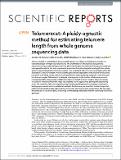Files in this item
Telomerecat : a ploidy-agnostic method for estimating telomere length from whole genome sequencing data
Item metadata
| dc.contributor.author | Farmery, James | |
| dc.contributor.author | Smith, Mike | |
| dc.contributor.author | NIHR BioResource - Rare Diseases | |
| dc.contributor.author | Lynch, Andy | |
| dc.date.accessioned | 2018-01-23T15:30:10Z | |
| dc.date.available | 2018-01-23T15:30:10Z | |
| dc.date.issued | 2018-01-22 | |
| dc.identifier | 251746309 | |
| dc.identifier | 96a95404-9ab6-4dcd-91d8-ec5295451131 | |
| dc.identifier | 85040985054 | |
| dc.identifier | 000422904600013 | |
| dc.identifier.citation | Farmery , J , Smith , M , NIHR BioResource - Rare Diseases & Lynch , A 2018 , ' Telomerecat : a ploidy-agnostic method for estimating telomere length from whole genome sequencing data ' , Scientific Reports , vol. 8 , 1300 . https://doi.org/10.1038/s41598-017-14403-y | en |
| dc.identifier.issn | 2045-2322 | |
| dc.identifier.other | ORCID: /0000-0002-7876-7338/work/41026514 | |
| dc.identifier.uri | https://hdl.handle.net/10023/12591 | |
| dc.description | Funding: Cancer Research UK Programme Grant to Simon Tavaré (C14303/A17197) (JHRF, AGL, MLS); European Commission through the Horizon 2020 project SOUND (Grant Agreement no. 633974) (AGL). | en |
| dc.description.abstract | Telomere length is a risk factor in disease and the dynamics of telomere length are crucial to our understanding of cell replication and vitality. The proliferation of whole genome sequencing represents an unprecedented opportunity to glean new insights into telomere biology on a previously unimaginable scale. To this end, a number of approaches for estimating telomere length from whole-genome sequencing data have been proposed. Here we present Telomerecat, a novel approach to the estimation of telomere length. Previous methods have been dependent on the number of telomeres present in a cell being known, which may be problematic when analysing aneuploid cancer data and non-human samples. Telomerecat is designed to be agnostic to the number of telomeres present, making it suited for the purpose of estimating telomere length in cancer studies. Telomerecat also accounts for interstitial telomeric reads and presents a novel approach to dealing with sequencing errors. We show that Telomerecat performs well at telomere length estimation when compared to leading experimental and computational methods. Furthermore, we show that it detects expected patterns in longitudinal data, repeated measurements, and cross-species comparisons. We also apply the method to a cancer cell data, uncovering an interesting relationship with the underlying telomerase genotype. | |
| dc.format.extent | 17 | |
| dc.format.extent | 3013643 | |
| dc.language.iso | eng | |
| dc.relation.ispartof | Scientific Reports | en |
| dc.subject | QH301 Biology | en |
| dc.subject | RC0254 Neoplasms. Tumors. Oncology (including Cancer) | en |
| dc.subject | T Technology | en |
| dc.subject | DAS | en |
| dc.subject | SDG 3 - Good Health and Well-being | en |
| dc.subject.lcc | QH301 | en |
| dc.subject.lcc | RC0254 | en |
| dc.subject.lcc | T | en |
| dc.title | Telomerecat : a ploidy-agnostic method for estimating telomere length from whole genome sequencing data | en |
| dc.type | Journal article | en |
| dc.contributor.institution | University of St Andrews. Statistics | en |
| dc.contributor.institution | University of St Andrews. School of Medicine | en |
| dc.contributor.institution | University of St Andrews. Population and Behavioural Science Division | en |
| dc.contributor.institution | University of St Andrews. Cellular Medicine Division | en |
| dc.identifier.doi | 10.1038/s41598-017-14403-y | |
| dc.description.status | Peer reviewed | en |
This item appears in the following Collection(s)
Items in the St Andrews Research Repository are protected by copyright, with all rights reserved, unless otherwise indicated.

